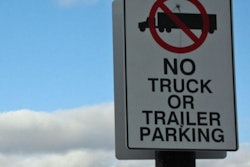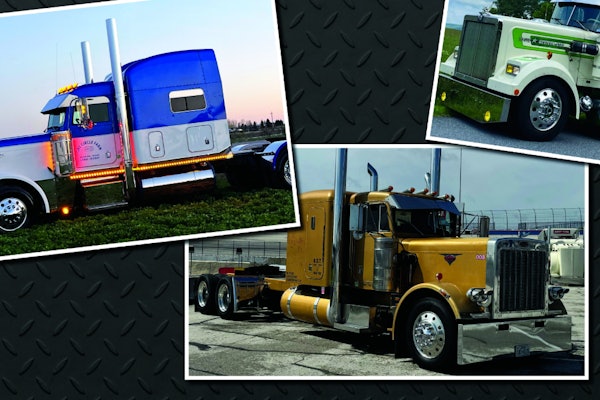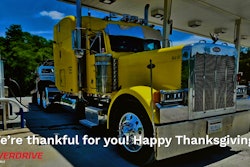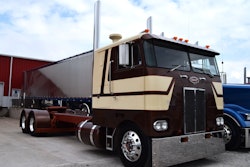Both sides await a ruling from the U.S. 9th Circuit Court of Appeals after a hearing on whether the federal cross-border trucking program with Mexico should continue.
On Feb. 12, attorneys for the Teamsters, the Owner-Operator Independent Drivers Association, Public Citizen and the Sierra Club argued that the Federal Motor Carrier Safety Administration broke the law by continuing the project in defiance of the fiscal 2008 omnibus spending bill that President Bush signed Dec. 26. About 450 Teamsters rallied against the program outside the San Francisco courtroom, said Leslie Miller, a union spokeswoman.
When the three-judge panel will issue its ruling is unknown, said Charles Miller, a U.S. Department of Justice spokesman.
The court decided Jan. 23 that it would consider in its ruling an amendment – part of the package signed by President Bush – that was intended by its sponsor, U.S. Sen. Byron Dorgan, D-N.D., to cut off money to the cross-border program. The FMCSA maintains the ban on funding to “establish” such a program bars it only from creating any new cross-border project with Mexico, not from continuing the program started Sept. 6.
Dorgan is trying to schedule a hearing to ask Mary Peters, secretary of the U.S. Department of Transportation, to justify that decision.

The agency’s legal brief in the case stated that the petitioners had not proven they had standing in the case – that is, that they had been harmed or would be harmed by the program. The agency also repeated its contentions that the project is safe and meets congressional mandates.
Judge Dorothy Nelson seemed sympathetic to the plaintiffs, while Judge Andrew Kleinfeld seemed sympathetic to the administration. Judge Michael Daly Hawkins’ position was unclear.
“Why isn’t this case moot with the act of Congress?” Nelson asked.
Jonathan Weissglass, who represented the plaintiffs other than OOIDA, replied that the program had proceeded even after the amendment was signed into law.
“They’re continuing on, even with the low number of truckers?” Nelson asked – a reference to the congressional mandate that the program be statistically valid.
Kleinfeld said the low number of participants – a total of 42 Mexican trucks so far – does not make the project invalid as a test of opening the border, as opponents have argued. “You can get statistical significance out of 42 trucks,” he said.
OOIDA’s attorney, Paul Cullen Sr., said the agency lacked authority to accept Mexican regulations as equal to U.S. regulations. Mexico’s standards are not equal to those in the United States, he said. For example, American truckers’ CDLs are affected by violations involving private vehicles, but the same is not true in Mexico, he said.
Moreover, granting exemptions to regulations is a complex process that the FMCSA did not follow, Cullen argued.
FMCSA attorney Irene Solet said that the program’s safety process was satisfactory and that the public had sufficient opportunity to comment on Mexican carriers.
The court questioned the relevance of SafeStat statistics that OOIDA claims show Mexican carriers were OK’d despite having high numbers of violations. Those statistics, the court suggested, predate the launch of the 2007 program and its clearance procedures.
The court noted the last inspector general’s report on the program stated that Nebraska, Montana, Utah, Nevada and Rhode Island were not prepared to conduct safety investigations on Mexican carriers.
Since that report, Solet said, there has been considerable training of border officials. Moreover, what is required of them is that they be prepared to notify the DOT of problems, she said.
Since the inspector general noted those states lacked the staff or money to do enforcement, Nelson said, she questioned how well they could be alerted to safety problems.
Miller said he could not discuss the hearing beyond what was said in the brief.
Also declining to comment on the hearing was FMCSA spokeswoman Melissa Mazzella DeLaney. “We are moving forward with this program in a very careful and measured fashion,” she said.
The current drayage system at the Mexican border – mandated by the years-long ban on long-haul cross-border trucking – inflates costs, increases congestion and worsens border pollution, she said.
The cross-border program gives U.S. carriers the same right to haul across Mexico that Mexican carriers are given to haul across the United States, DeLaney said. “It’s ironic that Mr. (Teamsters President James) Hoffa – and I’m sure that Teamsters are hardworking people – is spending Teamsters dues to deny these opportunities for new earnings.”
– Jill Dunn
International Launches New LoneStar Tractor
International Truck and Engine unveiled its new flagship tractor, the LoneStar, Feb. 7 at the Chicago Auto Show. The LoneStar also was scheduled for an industry-wide showcase at the Mid-America Trucking Show in Louisville, Ky., last month.
The futuristic-looking LoneStar merges the classic styling preferred by chrome lovers with aerodynamic design and technologies sought by fuel-conscious owner-operators to create a new Class 8 category called “Advanced Classic,” the company said.
The LoneStar can be ordered from International dealers beginning in April for fall delivery. Production will begin in August at Navistar’s plant in Chatham, Ontario.
The LoneStar is projected to be 5 percent to 15 percent more fuel-efficient than classic trucks, equating to an annual savings of $3,000 to $8,000, the company said.
The LoneStar’s aerodynamic hood, windshield and side skirts will save truckers “real money,” said David Allendorph, chief designer for Navistar’s Truck Group. “Truck pros can have a unique, customizable truck that will reward them at the pump.”
Unusually, the truck progressed directly from math and clay models to production without any development prototypes. Company engineers “felt confident that we could develop this truck without spending months in prototyping,” said Tom Baughman, vice president and general manager of the Navistar Heavy Truck Vehicle Center. “We knew we had a winning truck, and we wanted to make it available to our customers as soon as it could be ready.”
The LoneStar is the result of automotive-inspired design and extensive customer research, including interviews with hundreds of drivers, International said. The LoneStar offers improved ergonomics, an industry-leading suspension, advanced electronics and a quiet cab, the company said.
“This truck is unlike anything on the road today,” said Daniel C. Ustian, Navistar chairman, president and CEO, adding that the LoneStar combines “peak productivity with emotional appeal.”
“Now, drivers don’t have to compromise,” said Dee Kapur, president of the Navistar Truck Group. “They can have it all: looks, efficiency, comfort, functionality and productivity.”
The distinctive grille and sloped hood were inspired by International’s innovative D Series trucks of the 1930s, which boasted pontoon fenders, split windshields and passenger-car looks. A restored and modified example of that truck, the DMAXX, was on display at International’s booth.
The LoneStar’s automotive-style features include:
- Standard ABS
- Roll stability
- Traction control
- Bluetooth integration for hands-free phone use
- Leather-wrapped steering wheel
- Automotive-style dash and gauges with rosewood or titanium trim
- 50-degree wheel cut
“In an average week, a truck driver may spend 120 hours in his or her truck – driving, eating, sleeping, running a business, even entertaining friends,” Allendorph said. “We designed the LoneStar’s environment to be both highly functional and comfortable. No other truck’s interior delivers the style, comfort and practicality we have built into the LoneStar.”
Interior highlights include:
- Wood flooring in the sleeper cab
- Sofa-bed design with back pillows
- Swivel chairs
- Closed “airline” cabinets for maximum storage
- Monsoon stereo system with 11 speakers, sub-woofer and amplifier
- Pull-down bed with 42-inch premium mattress
- Workspaces to plug in laptop computers and work in a desklike setting
- Mini refrigerator
– Randy Grider
Truck-Fatality Statistics at Record Lows
Three of the primary measures of fatal accidents involving large trucks fell to record lows in 2006, according to the U.S. Department of Transportation.
Newly released Federal Highway Administration vehicle mileage figures, used to determine annual crash rates, showed that the large truck involvement rate in fatal crashes, the large-truck fatality rate and the fatal crash rate for large trucks each declined to its lowest level since the DOT began tracking large truck safety records in 1975.
The 2006 fatal crash rate for large trucks stood at 1.93 fatal crashes per 100 million vehicle miles traveled, breaking the previous low of 1.97 in 2002. The large truck involvement rate fell to 2.12 involved trucks per 100 million vehicle miles traveled, down from 2.21 a year earlier. The fatality rate declined to 2.24 deaths per 100 million vehicle miles traveled, down from 2.34 in 2005.
According to FHWA, there were nearly 3 million more registered cars and trucks in 2006 than in 2005.
“These figures illustrate the effectiveness of the trucking industry’s continuous efforts to increase safety on the nation’s highways,” said Bill Graves, American Trucking Associations president.
– From Staff Reports
Diagnostics to Complicate 2010 Engines
The U.S. Environmental Protection Agency wants to be sure that when the 2010 engines hit the highways, they will continue to meet mandated emissions levels over the course of their useful life.
How will EPA ensure continued compliance? By also mandating the use of certified onboard diagnostic systems (OBD) for the engines and their fuel and aftertreatment systems, engine manufacturers said in a Feb. 4 panel at the Technology and Maintenance Council annual meeting in Orlando, Fla.
With OBD, a computer alerts the operator when any problem arises, electrical or mechanical, that could affect emissions. For example, a fleet running a 2010 engine with a cracked particulate filter would be able to catch the problem before emissions passed the regulated level.
The California Air Resources Board originally created OBD rules for passenger vehicles. Similar rules will be applied to heavy-duty vehicles, phased in through 2019.
Systems monitored by OBD will include the crankcase vent, fuel, exhaust gas recirculation, boost pressure control, particulate filter, cooling and NOx reduction catalyst. OBD requirements include:
- All diagnostics should run at least once per drive cycle, typically defined as engine start, engine running and engine off.
- The system must have an operator interface, called a malfunction indicator lamp, that exclusively indicates emissions faults.
- Service information must be adequate to guide a technician to the condition causing the problem and must be available to any service provider at reasonable cost.
Overall, the panelists agreed that while OBD will ensure emissions compliance, it also will make troubleshooting complicated.
Panelists were Jim Roal of Caterpillar, Ben Zwissler of Cummins, Greg Gillham of Detroit Diesel, Tim Gundrum of International Truck and Engine, and Keith Doorenbos of Kenworth Truck.
– Linda Longton
Fleets See Pros, Cons of New Engines
Lower-emissions heavy-duty engines have advanced in some areas since rollouts in 2002 and 2004, but there is still room for improvement, fleet representatives told the annual meeting of the Technology and Maintenance Council.
The consensus among the panelists Feb. 4 was that drivers favor the drivability of the engines because of the power curve. “Drivers have reported they noticed considerable acceleration improvements,” said Dan Umphress, managing director of maintenance solutions for FedEx.
“Drivers enjoy the responsiveness of the engines,” said Tom Newby, director of field maintenance for Old Dominion Freight Line.
While fuel mileage suffered with the first-generation engines, the gap between newer engines and pre-2002 power plants is shrinking, Umphress said. “The mpg is back within 3 percent of pre-’02/’04 engines,” he said.
Schneider National’s miles per gallon are about 5 percent more than in pre-lower-emissions engines, and overall operating costs are 6 cents to 8 cents more per mile, said Steve Duley, the fleet’s vice president of purchasing.
The maintenance costs of exhaust gas recirculation engines were high in the first year, but OEMs have found problems and fixed them, the panelists agreed.
In addition to overall OEM price increases, the 2007 engines have required additional driver education because of more manual regeneration than expected, the panel noted. Technicians also have needed more training.
The panelists reported service intervals for oil changes have been consistent, but Duley said fuel filter change intervals have had to be revamped.
Unknowns of the 2007 engines include the life of diesel particulate filters and aftermarket components such as turbochargers, the panelists said.
– Randy Grider
Michelin to Work on Rolling Resistance
Michelin is investing $6.8 million in research and development to improve fuel economy by reducing tire rolling resistance.
Though much of the work will be done internally through Michelin Americas Research, the investment includes a $1.9 million contract with Clemson University and its International Center for Automotive Research. The work will begin immediately and is set to be completed in three years.
“We believe that the future, not only of the automotive industry but also of transportation and mobility, lies in the imaginations and hands of these researchers searching for ways to improve fuel economy and overall mobility,” said Jim Micali, president of Michelin North America, based in Greenville, S.C.
In October 2007, Michelin announced plans to reduce tire-related energy consumption and associated greenhouse gas emissions. Those plans include reducing rolling resistance, the force that must be overcome to move vehicle tires forward, by half.
Tires consume up to 20 percent of the energy needed to operate an automobile, and for commercial trucks the impact may be even higher, past 30 percent, Michelin said.
– From Staff Reports
FYI | News Briefs
National Diesel Prices Soar
The national average retail price of a gallon of diesel soared 15.6 cents from the previous week to set a new all-time record high of $3.552 for the week ending Monday, Feb. 25, according to the U.S. Department of Energy. The price, which has climbed 27.2 cents in the last two weeks, is $1.001 higher than the same week last year. The previous record high of $3.444 was set on Nov. 26, 2007.
Truck Tonnage Index Increases
The American Trucking Associations’ advanced seasonally adjusted For-Hire Truck Tonnage Index increased 2.4 percent in January 2008 after rising an amended 1.5 percent in December 2007. ATA revised the seasonally adjusted index back five years; the new seasonal factors resulted in slightly lower truck tonnage volumes for 2007 than previously reported. ATA’s Truck Tonnage Index fell 1.5 percent in 2007 from the previous year; ATA originally reported a 1.4 percent drop.
Trucking Family Contest Deadline Nears
Truckers News is looking for a family with deep roots in trucking. The 2008 Great American Trucking Family contest rewards one family with its annual award to be presented at the Great American Trucking Show, Aug. 21-23 in Dallas. Industry honors and community involvement will be among the judging criteria. Entries must be postmarked by May 1 or e-mailed by that date to Executive Editor John Latta at [email protected]. Entries can also be submitted online at www.truckersnews.com.
Kenan Advantage Buys Transport Service Co.
Kenan Advantage Group, the nation’s largest bulk transportation and logistics provider to the petroleum and niche chemical industries, announced an agreement to buy Transport Service Co. The transaction was anticipated to close by the end of February. TSC supplies bulk distribution to the chemical and food products industries and has 18 terminals and about 750 employees, including 525 company drivers and 90 owner-operators.
Daimler Market Share Lead
Daimler Trucks North America announced that for the first time in its history, it surpassed its competitors in medium-duty market share in 2007. DTNA reported 31.5 percent of the Class 6 and Class 7 market, compared to 30.6 percent for Navistar International. DTNA also reported that in 2007 it continued to be the leader in market share for Class 8 commercial vehicles, besting International by 14.6 percentage points and Paccar by 8.3 percentage points.
Port Drops Employee Requirement
The Port of Long Beach, which had been working in lockstep with the Port of Los Angeles on a Clean Trucks Program, has dropped a provision that truckers must be employees, not owner-operators, and has stipulated that at least half of its program-financed trucks must operate on alternative fuels. Apparently surprising their Los Angeles counterparts, Long Beach port commissioners unanimously agreed Feb. 19 to allow only “clean” concession trucks at the port, but to permit those trucks to be driven by owner-operators
Trucking Documentary Makes Debut
Alligator on the Zipper, a documentary film exploring the lives of women truck drivers, recently debuted at the 10th Annual San Francisco Independent Film Festival. The film was shown at The Roxy Theater in February. Featuring unique and striking cinematography, Alligator on the Zipper was directed by Bulgarian filmmaker Ivo Stainoff, whose childhood experiences influenced the film.
Peterbilt Hybrid’s Tax Credits
Peterbilt’s medium-duty hybrid vehicles purchased in the United States are eligible to receive a tax credit of up to $12,000 from the federal government. The Department of Treasury’s heavy manufacturing and transportation group certified the Peterbilt Model 335 Class 7 and Model 330 Class 6 Hybrid Electric vehicles as eligible for these credits.











